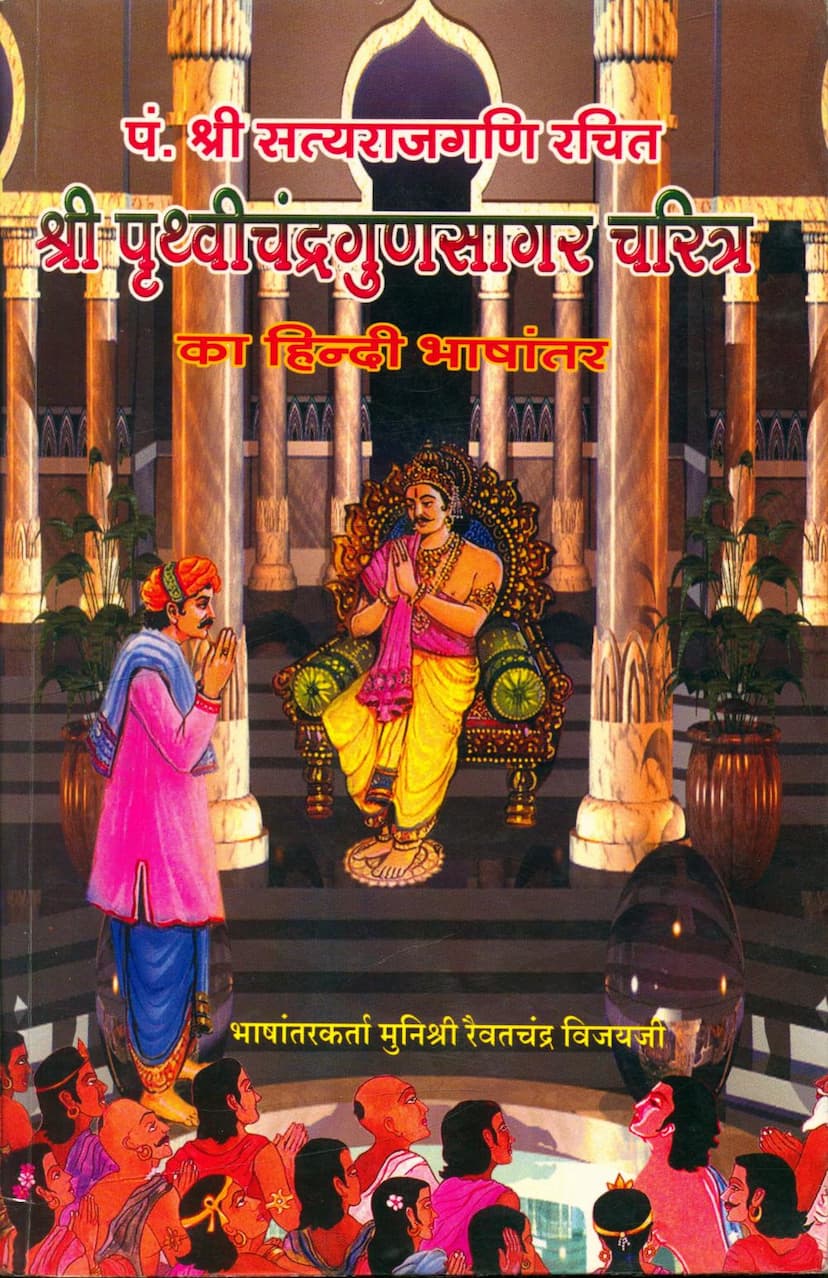Pruthvichandra Gunsagar Charitra
Added to library: September 2, 2025

Summary
The "Pruthvichandra Gunsagar Charitra" is a significant Jain text authored by Pandit Shri Satyarajgani and translated into Hindi by Munishri Raivatchandravijay. Published by Padmashree Marketing, this comprehensive biography chronicles the lives and spiritual journeys of various individuals across multiple lifetimes, illustrating the principles of Jainism.
The text is structured into ten "bhavas" (lifetimes), tracing the karmic path of key figures, most notably King Pruthvichandra, whose earlier lives are detailed. Through these narratives, the book highlights the Jain concepts of karma, moksha (liberation), ahimsa (non-violence), brahmacharya (celibacy), and the importance of righteous conduct.
Key Themes and Narratives:
The Charitra unfolds through a series of detailed life stories, demonstrating the transmigration of souls and the consequences of actions. Several prominent lives and their associated moral lessons are presented:
-
First Life (King Shankh and Kalavati): This story introduces King Shankh, who becomes enchanted by a painting of a beautiful maiden, Kalavati. This encounter leads to a series of events involving travel, rescue, courtship, marriage, and the eventual birth of a virtuous son. The narrative emphasizes the power of destiny and the importance of righteous actions even in the face of adversity. Kalavati's unjust suffering and eventual reunion with her husband, King Shankh, underscore themes of patience and karma.
-
Second Life (King Kamalssen): King Kamalssen, a virtuous ruler, is depicted as being detached from worldly pleasures. His journey involves encounters with various spiritual figures and tests of his character. He demonstrates a strong adherence to Jain principles, even when faced with temptation or difficult circumstances. His encounters with King Gunsen and the subsequent events highlight the importance of ethical decision-making and the consequences of attachment. The story of the four wives of Vinayandhar, and their previous lives as virtuous women, also illustrates the impact of past karma on present relationships.
-
Third Life (King Devsen): King Devsen's story focuses on his pursuit of spiritual knowledge and righteousness. He encounters religious figures and learns about the transient nature of worldly possessions. His journey emphasizes the importance of devotion, detachment, and the ultimate goal of liberation. The narrative also touches upon the consequences of actions, as seen in the contrast between the virtuous Devsen and the misguided individuals he encounters.
-
Fourth Life (King Devarath): King Devarath's life highlights the importance of compassion, righteousness, and the pursuit of spiritual wisdom. His encounters with various individuals, including Vidhyadhars and sages, offer lessons on the nature of karma and the path to liberation. The story of his virtuous reign and eventual renunciation demonstrates the Jain ideal of detachment from worldly affairs.
-
Fifth Life (King Purnachandra and Pushpasundari): This life chronicles the spiritual journey of King Purnachandra, who, despite his prosperous reign and loving wife Pushpasundari, experiences disillusionment with worldly pleasures. Inspired by a sage, he renounces his kingdom and embraces a life of austerity, ultimately achieving spiritual merit. The narrative underscores the impermanence of material possessions and the eternal bliss found in spiritual practice.
-
Sixth Life (King Narsingh and King Surasen): This life emphasizes the importance of virtuous conduct, compassion, and the pursuit of spiritual liberation. King Narsingh's reign is marked by his devotion to Jain principles and his efforts to uphold righteousness. His encounters with various spiritual figures and his eventual renunciation of worldly pleasures highlight the Jain path to enlightenment. The story also illustrates the karmic consequences of actions through the contrasting fates of different individuals.
-
Seventh Life (King Pabhottar and King Hariveg): This life further explores themes of karma and spiritual pursuit. King Pabhottar's journey involves spiritual enlightenment through his association with virtuous individuals and his adherence to Jain teachings. The narrative highlights the transformative power of righteousness and the ultimate attainment of liberation.
-
Eighth Life (King Girisundar and King Ratnasar): This life focuses on the importance of brotherly love, spiritual devotion, and the pursuit of liberation. The bond between brothers Girisundar and Ratnasar is tested, but their ultimate commitment to righteousness and spiritual practice leads them to a higher plane of existence. Their journey showcases the significance of virtuous relationships and the rewards of spiritual dedication.
-
Ninth Life (King Kanakdhwaj and King Jayasundar): This life emphasizes the value of spiritual wisdom and the detrimental effects of worldly attachments. King Kanakdhwaj's renunciation of his kingdom and his embrace of spiritual discipline illustrate the Jain ideal of detachment. The narrative highlights the transient nature of worldly pleasures and the enduring bliss found in spiritual pursuits.
-
Tenth Life (King Kusumaketu): King Kusumaketu's story centers on the pursuit of spiritual knowledge and the importance of righteous actions. His encounters with virtuous individuals and his adherence to Jain principles demonstrate the path to liberation. The narrative emphasizes the transformative power of detachment and the ultimate attainment of spiritual bliss.
-
Eleventh Life (King Pruthvichandra): The final and culminating life described is that of King Pruthvichandra, who embodies the culmination of his previous spiritual efforts. Through his reign, he demonstrates the practical application of Jain ethics, emphasizing compassion, righteousness, and the pursuit of liberation. His journey illustrates the culmination of his karmic journey, leading to the attainment of kevalgyan (omniscience) and eventual moksha. The narrative also highlights the stories of other virtuous individuals who achieve liberation through their adherence to Jain principles.
Overall Message:
The "Pruthvichandra Gunsagar Charitra" serves as a moral compass, guiding readers through the complexities of life and the consequences of their actions. It emphasizes that true happiness and lasting fulfillment are found not in worldly possessions but in the practice of virtue, righteousness, and spiritual discipline, as taught by the Jain Tirthankaras. The book's extensive narratives across multiple lifetimes offer a profound exploration of Jain philosophy and its practical application in leading a meaningful and spiritually rewarding life.